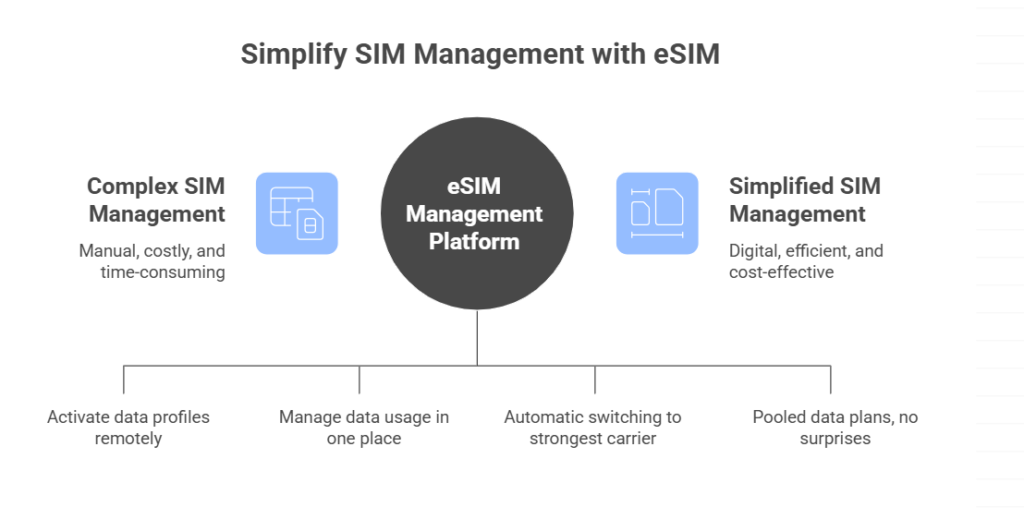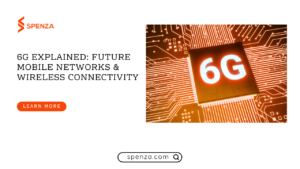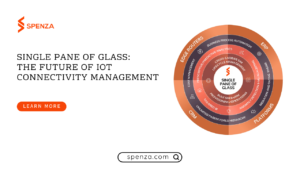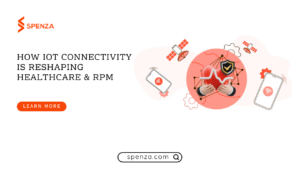Table of Contents
- Introduction: Your Employee’s Home Wi-Fi is Not a Business Strategy
- The Problem: Why Relying on Home Wi-Fi Alone is Failing Hybrid Teams
- Productivity & Business Continuity
- Security Risks
- Inequity and Connectivity Gaps
- The “Work from Anywhere” Challenge
- The Solution: An “Always-On” Mobile Connectivity Strategy
- Cellular as the Primary Backup
- A Secure Corporate Network, Anywhere
- Democratizing Access
- Making it Manageable: The Power of an eSIM Management Platform
- Zero-Touch Deployment
- Centralized Control
- Multi-Carrier Flexibility
- Predictable Costs
- Why Mobile First Wins
- Security and Compliance in 2025
- Regional Trends in Mobile Connectivity for Remote & Hybrid Teams
- The Growing Role of Mobile in Digital Transformation
- Why IT Leaders Must Act Now
- Productivity and Cost Impact of Mobile Connectivity
- How Spenza Powers Mobile Connectivity for Remote and Hybrid Teams
- Final Thoughts
- FAQS

TL;DR (For Brands)
- Home Wi-Fi is not a corporate strategy for distributed work.
- Mobile connectivity for remote & hybrid teams ensures uptime, security, and equity.
- 75% of US remote-capable workers are at home at least part-time.
- Remote outages equal lost productivity and lost revenue.
- Managed corporate eSIM management makes global connectivity simple.
- Companies that adopt always-on connectivity see better retention and higher employee performance.
Introduction: Your Employee’s Home Wi-Fi is Not a Business Strategy
A dropped video call is no small issue. When a deal worth $500,000 collapses because the connection failed, the company pays the price. These disruptions are more common than many leaders admit. The majority of Americans still lack high-speed internet at home. Even in urban centers, home Wi-Fi falters during peak hours.
At the same time, demand for mobile data is exploding. In the US, 132 trillion MB of mobile data was consumed in 2024, a 32% increase from the prior year. This growth is not driven by casual browsing, it reflects how people now work, always connected, and often outside traditional offices.
Remote and hybrid work are now the norm, not the exception. Three out of four remote-capable employees spend at least part of their week at home. Yet most businesses still leave connectivity to chance, expecting staff to rely on home Wi-Fi, personal routers, or worse, public hotspots.
This approach is risky, inequitable, and short-sighted. In this blog, we’ll explain why mobile connectivity for remote & hybrid teams must be a formal business strategy. We will look at hidden risks, costs, and how companies can move toward secure, managed connectivity.
The Problem: Why Relying on Home Wi-Fi Alone is Failing Hybrid Teams
Most companies still depend on employee home Wi-Fi for daily operations. But this approach is unreliable, insecure, and inequitable. Below are the key risks businesses face when they leave connectivity up to chance.

Productivity & Business Continuity
Remote productivity hinges on stable internet. A single outage can shut down an employee for an entire day. Multiply that by a 1,000-person company, and the cost is staggering. Gartner estimates that the average cost of downtime is $5,600 per minute for large organizations.
This is why remote workforce connectivity is now a matter of business continuity, not convenience. Home internet lacks redundancy. If it fails, work stops. There is no built-in backup. Even tech-savvy employees who tether phones often hit carrier data caps within hours.
And outages are increasing. In 2024, both Comcast and AT&T reported multi-hour service disruptions that impacted millions of users. A company relying on employee home Wi-Fi has no way to mitigate these failures.
Security Risks
Security breaches are not limited to phishing emails. They also arise from insecure networks. Public Wi-Fi in cafes or airports exposes workers to man-in-the-middle attacks. Even home routers can be compromised if firmware is outdated or default passwords remain.
Data shows that remote employees are three times more likely to face cyberattacks than office-based peers. Corporate IT has no control over these consumer-grade networks. Worse, employees often mix personal and professional use, blurring the boundary even further.
The solution is not endless training. It is providing secure mobile access for employees that IT can control. With company-managed mobile connectivity, every bit of traffic can route through VPNs or zero-trust gateways. That keeps sensitive information safe while ensuring compliance with regulations like GDPR and HIPAA.
For leaders exploring more structured telecom solutions, Spenza’s Telecom-as-a-Service model shows how cloud-native infrastructure supports secure, mobile-first operations.
Inequity and Connectivity Gaps
Remote work was supposed to equalize opportunity. But connectivity divides employees into two groups: those with fast fiber and those stuck with unreliable DSL or capped satellite plans. This inequity directly impacts performance reviews, promotions, and career growth.
A Microsoft study found that 62% of remote workers believe poor connectivity has limited their career development. In practice, this means one employee shines in presentations, while another struggles just to stay connected. That is not a fair or sustainable system.
Businesses cannot afford “connectivity haves and have-nots.” True equity requires mobile connectivity for remote & hybrid teams that works everywhere, not just in select urban centers.
To understand the financial impact of uneven connectivity, leaders can review telecom expense management strategies that highlight how unmanaged services drive hidden costs.
The “Work from Anywhere” Challenge
Employees no longer work from just home or office. They work from airports, hotel rooms, client sites, and coworking hubs. Consumer internet cannot meet this reality. Work-from-anywhere requires business continuity solutions that travel with the employee.
Mobile connectivity solves this. A laptop or tablet with a managed data plan works globally. Employees are no longer tethered to home routers. Instead, they become portable offices.
This shift mirrors the adoption of eSIM technology. Already, enterprise eSIM solutions allow organizations to deploy global mobile profiles instantly, ensuring coverage wherever employees go.
These challenges make it clear: businesses need a stronger, always-on connectivity strategy.
The Solution: An “Always-On” Mobile Connectivity Strategy
To fix the weaknesses of home Wi-Fi, companies need a dedicated mobile-first approach. Always-on connectivity ensures that employees stay productive, secure, and connected no matter where they work.

Cellular as the Primary Backup
Every employee needs a cellular-connected device. Whether that’s a 5G laptop, a hotspot, or a smartphone, it creates an automatic failover. When Wi-Fi crashes, mobile data takes over. Work continues without interruption.
This is the foundation of always-on connectivity. It reduces lost time, protects revenue, and safeguards reputation. And it’s not theoretical. By 2025, 2.9 billion people worldwide will have 5G subscriptions. That means faster, more reliable backup is already available.
A Secure Corporate Network, Anywhere
Security doesn’t stop at the office door. Remote employees need the same protection wherever they work. Managed cellular connections make this possible. IT can enforce encryption, monitor usage, and require authentication.
With corporate-managed mobile networks, data travels through secure tunnels. This is what secure mobile access for employees should look like, consistent, monitored, and policy-driven.
The approach aligns with the broader trend toward Telecom-as-a-Service, explained in Spenza’s TaaS vs Traditional Telecom comparison. Companies are moving away from rigid contracts to flexible, API-first models.
Democratizing Access
Connectivity should not depend on zip code. When organizations standardize on remote workforce connectivity, they give every employee equal footing. The executive in New York has the same performance tools as the field engineer in Kansas.
By distributing managed mobile devices, companies remove inequity. Everyone has reliable access. Everyone can perform. That strengthens morale and retention.
The rise of global eSIM connectivity makes this more practical. A single profile can cover 190+ countries, eliminating roaming headaches and ensuring fair access for international staff.
Still, building and managing this at scale requires smarter tools.
Making it Manageable: The Power of an eSIM Management Platform
No IT leader wants to manage hundreds of individual SIM cards, invoices, and carrier contracts. The complexity is enormous. For hybrid teams spread across countries, it becomes unmanageable.
Here is where corporate eSIM management becomes vital. Instead of mailing SIM cards and juggling contracts, IT can activate profiles digitally. Employees get coverage instantly, anywhere.

- Zero-Touch Deployment: Ship a laptop anywhere. IT activates data remotely.
- Centralized Control: One dashboard for all data usage and limits.
- Multi-Carrier Flexibility: Devices switch to the strongest local carrier automatically.
- Predictable Costs: Pooled data plans prevent surprise bills.
This transforms mobile connectivity for remote & hybrid teams from a nightmare into a manageable system.
The benefits tie directly into Telecom-as-a-Service, where businesses shift from managing hardware to managing connectivity through a cloud-first model.
These benefits explain why mobile-first strategies are overtaking legacy systems.
Why Mobile First Wins
To ground this in reality, here’s what global data shows:
| Metric (2023–2025) | Value | Why It Matters |
|---|---|---|
| Global Avg. Cost per 1 GB | $2.60 | Wide regional variance |
| India (1 GB) | $0.09 | Cheapest data worldwide |
| US (1 GB) | $6.00 | Among the most expensive |
These numbers prove the case. Home Wi-Fi cannot deliver reliability, security, or fairness. Corporate-managed mobile connectivity is not just smarter, it’s cheaper when scaled correctly.
For teams exploring the differences in telecom models, the TaaS vs Traditional Telecom article explains why legacy setups are too rigid for today’s mobile-first workforce.
Still, success in mobile-first workforces also depends on compliance and security standards.
Security and Compliance in 2025
The remote attack surface keeps growing. Cybersecurity Ventures reports that global cybercrime costs will hit $10.5 trillion annually by 2025. Much of that risk comes from unmanaged endpoints and networks.
Secure mobile access for employees addresses this. By ensuring all traffic runs through company-managed tunnels, compliance becomes enforceable. HIPAA, PCI DSS, and GDPR protections no longer depend on employee habits.
At the same time, business continuity solutions make sure outages don’t translate into lost contracts. The right mobile setup keeps work alive under any conditions.
The facts are undeniable. Home Wi-Fi alone is fragile, insecure, and inequitable. Companies that continue to depend on it will face more outages, breaches, and frustrated staff.
The answer is corporate-level mobile connectivity for remote & hybrid teams. It ensures productivity, continuity, and fairness.
Compliance, however, differs across regions, and businesses must adapt globally.
Regional Trends in Mobile Connectivity for Remote & Hybrid Teams
Remote work is global, but mobile data access is not equal across regions. Companies planning global remote workforce connectivity need to understand these differences. Costs, reliability, and adoption rates vary widely.
| Region | Avg. Cost per GB (2024) | 5G Coverage (2025) | Key Challenge | Opportunity |
|---|---|---|---|---|
| North America | $6.00 | 74% | High cost of mobile data | Strong enterprise demand for business continuity solutions |
| Europe | $2.20 | 69% | Fragmented regulations | Broad carrier competition lowers costs |
| Asia-Pacific | $1.30 | 65% | Unequal rural access | Rapid 5G adoption, low cost per GB |
| Africa | $3.90 | 28% | Low 5G rollout | Leapfrogging with mobile-first workforce |
| Latin America | $2.70 | 41% | Network congestion | Growth in hybrid teams adopting always-on connectivity |
This table shows that while mobile networks are expanding, enterprises must plan regionally. Costs are steep in the US, but affordable in Asia. In Africa and Latin America, mobile connectivity is the best path for equity.
And while regions differ, one common truth is clear: mobile is becoming the core of digital transformation.
The Growing Role of Mobile in Digital Transformation
Remote work is only part of the story. Mobile networks are becoming the backbone of business. Cloud adoption, SaaS platforms, and IoT devices all depend on always-on connectivity. In fact, Ericsson projects mobile data traffic will quadruple between 2024 and 2030 as 5G expands.
For IT leaders, this means mobile is no longer “supplementary.” It is core. Building strategies around secure mobile access for employees ensures that cloud systems, collaboration tools, and AI platforms stay reliable.
This shift also strengthens business continuity solutions. Mobile-first infrastructure keeps work flowing when local internet fails. That resilience defines digital maturity in 2025.
For a deeper view of how global eSIM improves reliability, Spenza’s eSIM global connectivity guide explains how pooled data plans and multi-carrier coverage remove the gaps employees face in different geographies.
This rising role forces IT leaders to act sooner rather than later.
Why IT Leaders Must Act Now
Many leaders still treat connectivity as an individual responsibility. Employees file expense reports for hotspots. Managers reimburse data overages. This creates hidden costs and operational friction.
The smarter approach is centralized. By making corporate eSIM management part of IT strategy, companies reduce waste, secure networks, and simplify processes.
Those who delay will fall behind. Competitors with standardized mobile connectivity for remote & hybrid teams will run faster, serve clients better, and protect data more effectively.
The choice is simple: either stay reactive with home Wi-Fi, or adopt proactive business continuity solutions with managed mobile connectivity.
The cost of waiting shows up not only in risk but also in lost productivity and hidden expenses.
Productivity and Cost Impact of Mobile Connectivity
Connectivity is not just about staying online. It directly influences productivity, equity, and expenses. Organizations that build strategies around secure mobile access for employees see measurable returns.
| Factor | Without Mobile Connectivity | With Mobile Connectivity | Business Impact |
|---|---|---|---|
| Downtime Costs | $5,600 per minute (avg. enterprise loss) | Minimal due to backup coverage | Protects revenue and operations |
| Security Exposure | 3× higher attack risk on public Wi-Fi | Encrypted, IT-controlled mobile access | Reduces compliance failures |
| Employee Productivity | 6 hours lost per employee per month | Continuous access to apps and calls | More billable hours, higher output |
| Employee Equity | “Haves” with fiber outperform | All employees get same reliable access | Better retention and fairness |
| Operational Costs | Expense reports, reimbursements, roaming fees | Pooled data plans, predictable costs | Saves budget, simplifies accounting |
This comparison makes clear why business continuity solutions must include mobile data. Companies that treat mobile as secondary will continue to face hidden costs and productivity losses.
These productivity and cost factors point to one solution partner that can simplify the entire model
How Spenza Powers Mobile Connectivity for Remote and Hybrid Teams
In Part 1, we saw why home Wi-Fi alone is a failing strategy. Outages, inequity, and security risks make it unsustainable. The only path forward is a corporate-level approach to mobile connectivity for remote & hybrid teams.
This is where Spenza comes in. Spenza is not just another telecom provider. It is a modern MVNE that makes mobility easy for IT leaders, HR teams, and COOs. Spenza supports both traditional MVNOs and IoT deployments, offering everything needed to run mobile-first operations.
With Spenza, businesses don’t just buy SIM cards. They gain a platform that manages everything, from corporate eSIM management to billing, analytics, and global coverage in 190+ countries.
Why Spenza Fits the 2025 Reality
Spenza was designed for distributed work. Remote and hybrid teams demand agility, flexibility, and security. Spenza provides:
- Multi-carrier global coverage: Employees get the best local connection in over 190 countries.
- Zero-touch eSIM provisioning: IT can activate service on any device, anywhere.
- Cloud-native, API-first infrastructure: Everything integrates into your existing IT stack.
- Centralized billing and analytics: Predictable costs without messy expense reports.
- Support for always-on connectivity: Mobile data as backup, not employee expense.
This turns mobile connectivity for remote & hybrid teams into a system IT can control and employees can trust.
For a breakdown of how telecom costs fit into corporate strategy, the guide on telecom expense management shows why centralized oversight is key.
Final Thoughts
By now, it is clear: home Wi-Fi is not a strategy. The risks of outages, inequity, and weak security are too high. Mobile connectivity for remote & hybrid teams must be formal, managed, and secure.
Spenza makes this transformation practical. Through corporate eSIM management, always-on connectivity, and centralized analytics, IT leaders gain control. Employees gain fairness. Companies gain resilience.
The future of distributed work will not be won by those with the best office. It will be won by those with the best connectivity.
If your business is ready to move from patchwork to strategy, Spenza can help. With a global footprint, cloud-native infrastructure, and business continuity solutions built in, Spenza is the platform for the remote-first era.
FAQs
It lets IT manage all employee connectivity from one dashboard. Plans activate remotely, invoices consolidate, and carrier swaps happen digitally.
Because Wi-Fi outages are unpredictable. Backup mobile data ensures employees stay productive during failures, preventing lost revenue and reputation damage.
Not fully today. But for many remote and hybrid teams, cellular provides either primary access or a failover that ensures continuity.
By pooling data across employees and regions. Instead of unpredictable bills, companies see one consolidated monthly charge.
VPNs protect traffic but do not control the underlying network. Secure mobile access ensures the connection itself is reliable and within IT’s control.
Spenza ensures every employee has always-on, secure, and centrally managed connectivity. That keeps operations running even when the local internet fails.
Ready to build a resilient foundation for your communication stack? Contact Spenza to learn how our solutions can power your hybrid workforce.






